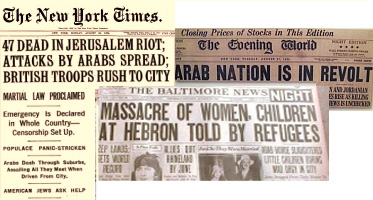Triggered by false rumors that Jews were planning to seize control of the Temple Mount in Jerusalem and take over the Al-Aqsa Mosque, on August 24, an Arab mob slaughtered over 60 Jews in the city of Hebron. Jewish homes were raided and looted and synagogues were ransacked. About 435 Jews survived due to the fact that Arab families had hidden them. After the massacre, the surviving Jewish community in Hebron was evacuated by British authorities and relocated to Jerusalem.
The aftermath of the slaughter left Hebron with zero Jewish citizens for the first time in hundreds of years. The massacre was a part of the 1929 Palestine riots in which a total of 133 Jews and 110 Arabs were killed, mostly by British police and security forces. This event sent waves of shock throughout Jewish communities in Palestine and all around the world and it led to the formation of the Haganah which later formed into the Israeli Defense Forces (IDF).
For hundreds of years, the Jewish community of Hebron had been living in peace in the ancient holy city coexisting among a population of tens of thousands of Arabs. In the summer of 1929, many Jewish immigrants were arriving which agitated the anti-semitic Mufti in Jerusalem who later befriended Adolph Hitler and was rumored to have suggested gas chambers as a means to exterminate the population. This spurred tension between the Jews and Arabs. There were frequent acts of violence leaving both Jews and Arabs dead and there were rumors being spread on both sides of the conflict.
Due to conflict in Jerusalem, the Grand Mufti told his followers that the Jews were planning on taking over the Temple Mount, and reconstructing the Jewish temple where the Dome of the Rock stood, and that part of their plans was to specifically raze the Al-Aqsa Mosque. Prior to this, the Mosque itself was not seen as anything significant in Islamic lore, in fact, the area was in disrepair. The Mufti's efforts also included a rebranding of the Mosque as a major part of the Islamic faith, rehashing myths that the Al Aqsa of Jerusalem was in fact, the Al Aqsa (the furthest Mosque) mentioned in the Quaran's story of Muhammad's Night Journey.
The Mufti's agitation sparked violence in Jerusalem which spread to other regions. In Hebron, which was spared from the violence so far, the local Arabs began carrying out small-scale attacks on the Jewish community. However, the Jews of Hebron still believed that the good relations they enjoyed with their Arab neighbors over the years would spare them from the type of violence that was occurring in Jerusalem. They hoped for the best, as usual, nothing too violent would happen in Hebron, but they didn’t know what was coming.
On Friday, August 24, the community’s faith cracked when the violence began, starting with a young Hebron yeshiva student who was stabbed to death. The next morning starting at 8:00 a.m. on the Jewish Sabbath, the violence escalated and the Arab mobs were so large that they overpowered the police forces and were able to enter Jewish courtyards with no opposition. The mobs, armed with clubs, knives, and axes, went door to door in search of Jews, breaking into their homes and slaughtering anyone they found.
About 435 Jews were saved by two dozen Arab families who hid them in their homes from the mobs. The survivors were taken to the police station for shelter for the next three days and the Arabs still attempted to break into the station multiple times shouting “Kill the Jews!”. Finally, the British evacuated the survivors to Jerusalem. Following trials, there were three death sentences of Arabs involved.


